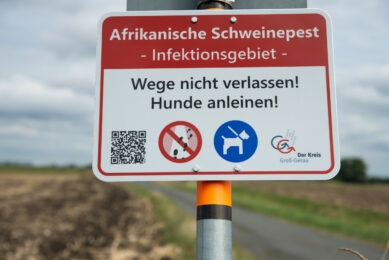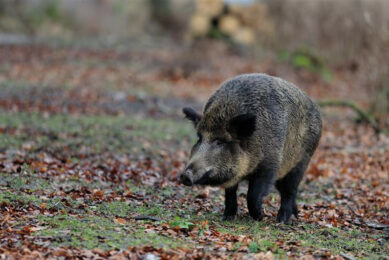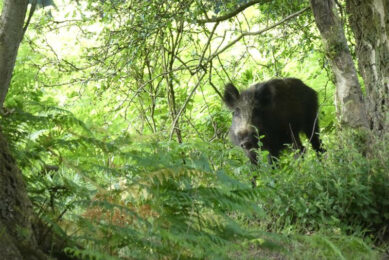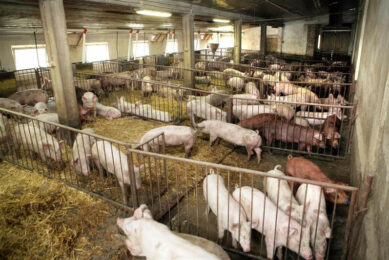How did the ASF virus spread in the Philippines?
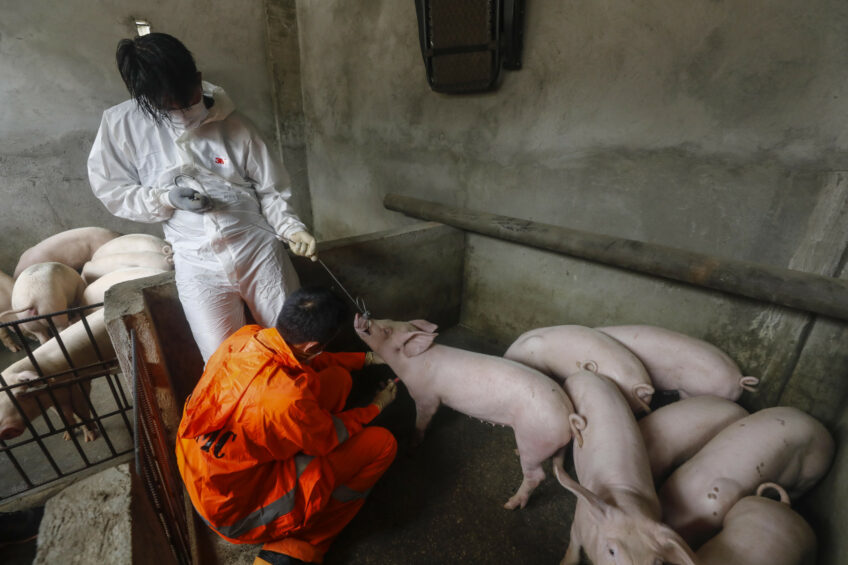
When the African Swine Fever (ASF) virus hit Asia, the infections took the countries like a whirlwind. That it was impactful and chaotic that much was clear. A few years down the road, it is possible to reconstruct what happened, figure out patterns and learn from them. In 2 papers, researchers at the University of Minnesota in the US did so for the ASF spread in the Philippines.
ASF was first detected in the Philippines in 2019, following earlier detections in Siberian Russia, mainland China (2018), and Vietnam (2019), just to name a few. The virus was first found in Rizal province — immediately east of the capital Manila — in July 2019. The virus proved not to discriminate — both large commercial farms and backyard farms were affected. And the country being an archipelago consisting of over 7,500 islands did not make much difference — in no time, the northern part Luzon, the centre area Visayas and the southern island Mindanao all reported infections with the virus. Extensive outbreaks were found in all 17 administrative regions of the country.
Pork production heavily impacted
As the disease status of ASF rapidly transitioned from epidemic to endemic, pork production was heavily impacted. Quoting Philippine government data, in 2021, there was a 41.7% reduction (about 2.01 million head) in the total registered swine population on commercial pig farms in the Philippines, leading to a subsequent inflation of pork prices. Backyard farms suffered losses as well, dropping from 7.97 million head in 2020 to 6.91 million in the third quarter of 2021. By March 2023, the country’s registered swine population had shrunk to about 10.18 million head, roughly 20.5% lower compared to the same quarter in 2020.
A few years further down the line, it is possible to look back and analyse the rapid spread of the virus. Where, when and why did the virus manage to replicate so quickly? And are there lessons to be learnt for the future?
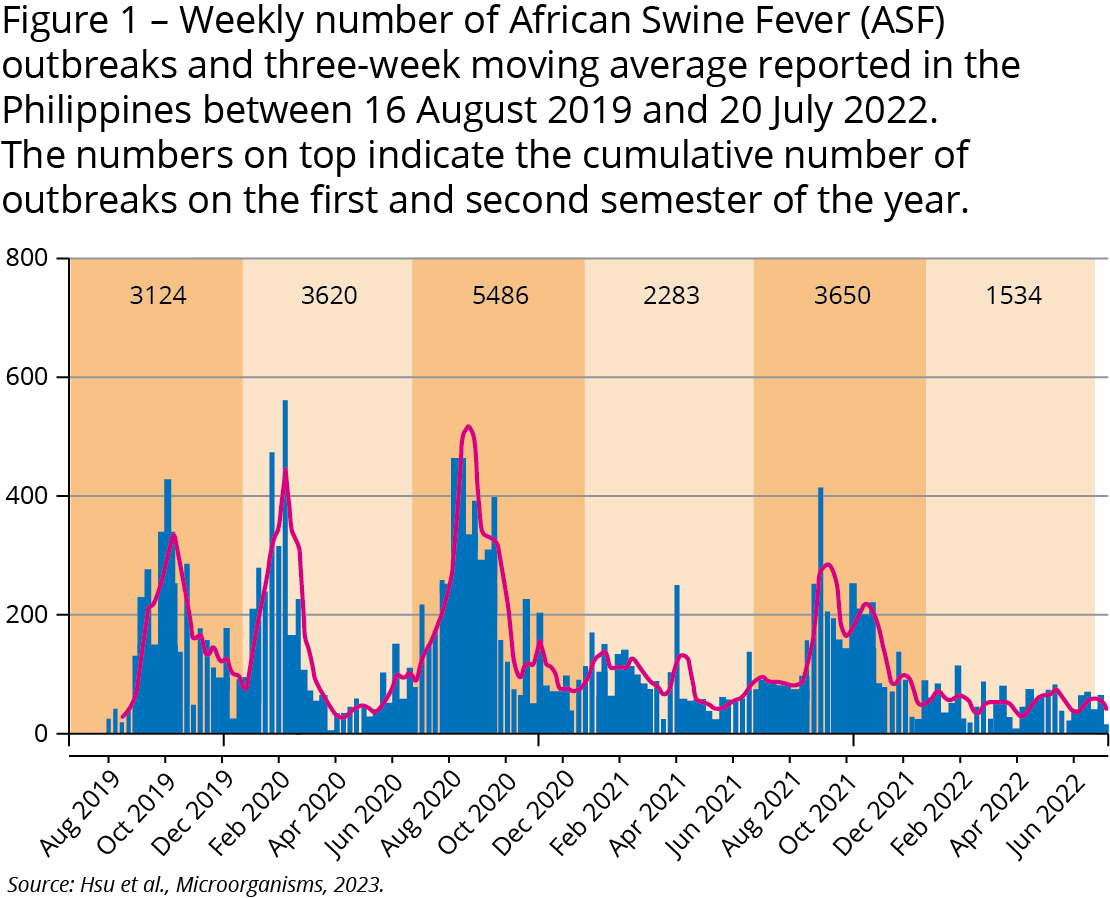
Studying 19,697 farm outbreaks
Exactly those questions aroused the interest of Dr Jesper Chia-Hui Hsu, researcher at the University of Minnesota in the United States. His team, supported by PIC, obtained many data related to farm outbreaks through the Philippine Department of Agriculture. Those data, covering a time period between August 2019 and July 2022, gave him and his team reports on 19,697 farm outbreaks which were available for further study.
With that number, the team worked on what they called a “space-time analysis” to learn when the outbreaks occurred. Results from the analysis can be seen in Figure 1. From the study, a pattern emerged with 5 peaks in total, which appeared to be seasonal.
Especially the 3 peaks between August and December jump out. In a publication in the peer-reviewed journal Microorganisms in 2023, Dr Hsu pointed to the coinciding of those peaks with the annual monsoon season. He wrote, “These results suggest that higher humidity levels, often associated with more rainfall, may contribute to the higher occurrence of ASF outbreaks in certain times of the year. Flooding can lead to the dispersal of carcasses and subsequent contaminations, causing leaching of the ASF virus into the ground. This increases the risk of the virus re-emergence during subsequent floods.”
Conversely, the following cool dry season (December–February) and hot dry season (March–May) are less favourable for the virus to thrive. “Based on seasonal index results and the characteristics of the disease pattern, it can be inferred that the cool dry season between December and February, with lower temperature and humidity levels, is less favourable for the spread of ASF. And the hot dry season from March to May, with higher temperatures and less rainfall, could also result in a lower occurrence of ASF outbreaks.”

Explaining the smaller ASF waves
The other 2 smaller waves of ASF virus, “in-between,” could be attributed to social phenomena, Dr Hsu and his team wrote. This has also been observed when analysing the spread in both China and Vietnam.
Dr Hsu and his team wrote: “Veterinarians with field experience in ASF in the Philippines indicated that, during the second half of the year, particularly during the third quarter which coincides with the start of the academic year, smallholders tend to sell pigs to fund education. However, because a reduction in the price of pigs is also typically seen at this time of the year, movements in search of best prices are common throughout the country. The increased human activity can result in more frequent movement of animals and pork-related products, which may contribute to the spread of ASF.”
ASF seems stronger in Luzon
Another thing that jumped out, Dr Hsu and his team wrote, is that the disease was most severe in the northern island of Luzon, at least during the first 3 years of the ASF outbreak. They wrote: “The space–time pattern suggests that the swine producers in Luzon Island faced a greater disease burden and more significant challenges in repopulating hogs than those on other islands.”
The situation was particularly fierce in the Philippine region of Calabarzon, a region south-east of the capital Manila, where most commercial farms are located. In the article, the team pointed to the combination of high human and pig population densities having caused the disease to move quickly. They wrote: “Additionally, a closely connected network of swine and swine-related products may have facilitated disease spread. […] In contrast, these factors are less prevalent in the southern part of the country.”
Biosecurity measures
The obvious question to ask is: what about practical biosecurity on a local level? What factors affected the spread, diagnosis and control of African Swine Fever? The role of biosecurity was investigated in a different study by Dr Hsu and his team, which was published in the peer-reviewed title Pathogens late 2023. To that end, his team invited a selected group of 25 expert veterinarians to share their opinions. The group had on average 20 years of experience and had “a certain amount of field experience” with ASF. They pointed to an interesting set of risk factors:
- Feeding swill or contaminated feed was identified as the most significant factor influencing ASF spread, yet there was also something funny with this factor. In the Philippines, there was a reduction in the frequency of swill feeding since the beginning of the epidemic. Hence, other routes may also have been responsible.
- The second highest concern in the swine industry related to human behaviour, especially that of moving personnel (such as vets, technicians and workers) between farms without proper biosecurity measures. The vets also pointed to the presence of hog traders (middlemen). Especially backyard farmers or small commercial producers, who lack direct access to customers, rely on them for pig sales.
- Third, the role of wild boar in relation to ASF is underestimated in Asia, and the Philippines has been categorised as having a medium risk level. Especially in regions with higher wild pig populations, like Ilocos, Cagayan Valley and Cordillera — all three in the north of Luzon island, an increased likelihood of wild boar contact may exist. In that context, stray cats and dogs could act as potential mechanical vector animals for ASF virus, the vets said.
- Fourth: Most Filipino swine producers were found to be familiar with most clinical signs associated with ASF in the Philippines. However, they were less quick in identifying clinical signs, like pneumonia, hydropericardium and acute respiratory distress syndrome. In terms of easy intervention, alarm bells should start ringing with a drop in feed consumption.
ASF control strategies in the Philippines
Interestingly, the group of veterinarians also reflected on control strategies. Dr Hsu and his team noted a difference between the approaches taken by large and smaller farms. They wrote: “The participants felt that commercial farms typically lean towards partial depopulation, whereas backyard farms have a higher rate of total depopulation. This may reflect an advantage of commercial farms, as typically they possess better resources and capabilities to manage and mitigate losses during ASF outbreaks.”
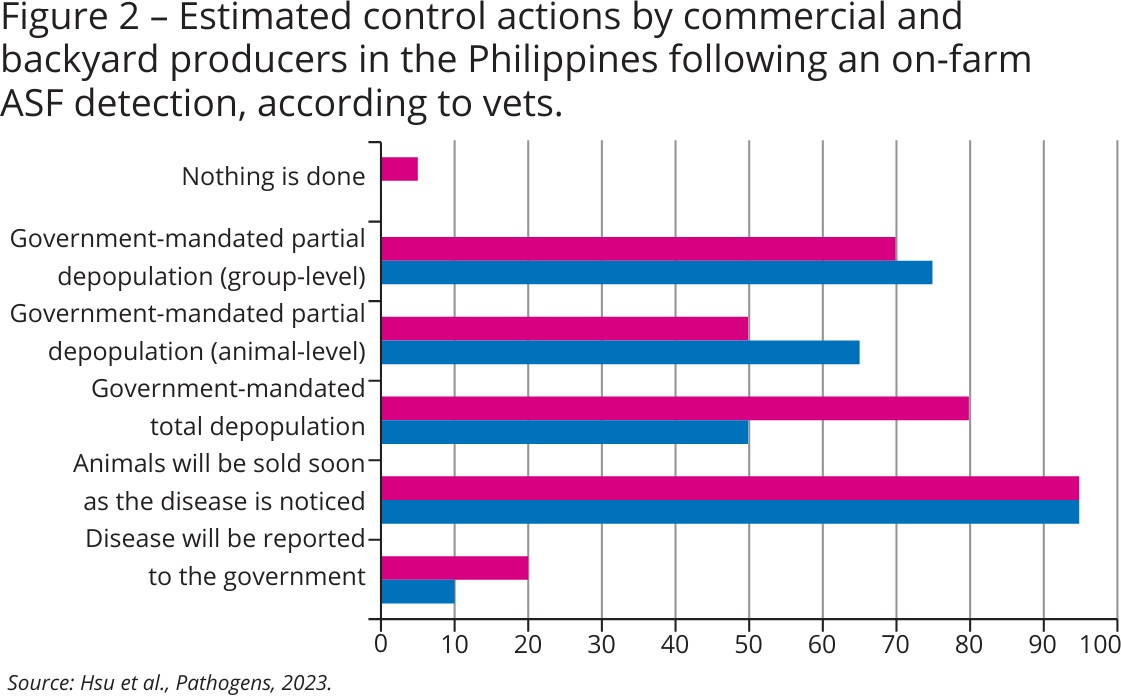
Another very interesting point made by the experts is that of the estimated low reporting rate for both commercial and backyard farms, which is also highlighted in Figure 2. Dr Hsu and his team wrote: “According to estimates from the participants, both commercial and backyard farmers frequently chose to sell their pigs (95%) once ASF was detected to prevent economic losses from total depopulation, which is mandated by Philippine government policies.”
He continued by finding perfect words for the underlying paradox, pointing to a lack of trust among farmers regarding the effectiveness of government assistance. Dr Hsu and his team wrote: “For example, farmers in both commercial and backyard settings bear the financial burden of burying dead pigs and processing affected animals, which can decrease their willingness to accurately report ASF cases. Concerns about the potential spread of ASF may lead farmers to resist access by government officials or veterinarians.”
Conclusion
Overall, in 2024, pig inventories are back to normal. In personal correspondence, Dr Hsu comments, “my opinion is that regarding the ‘inventory,’ according to their data, 2021 was the most severe time. Now, the growth rate of the swine inventory has become positive (around 3%–4% per year), so given the data, we could say there is a ‘slight recovery.’ However, from an economic point of view, the pork retail price is still hugely impacted compared to the price before ASF.”
Future research, he says, will focus on the longer term effects of ASF in the Philippines, and also pay attention to topics such as the impact of ASF on the environment, carcass disposal and river pollution.
All in all, the 2 studies perhaps capture what many may know already — yet this time the information has been documented very clearly in a scientific study. Veterinary knowledge may be very strong and convincing, but producers as well as the general public have to embrace policies, in order to make sure that human behaviour cannot be a deciding factor in the spread of the ASF virus. In that way, the knowledge contains a wise lesson for countries where the ASF virus has emerged or is still going to emerge. Having knowledge and policies is one thing, having everyone on board is another. Otherwise, history will keep on repeating itself.



